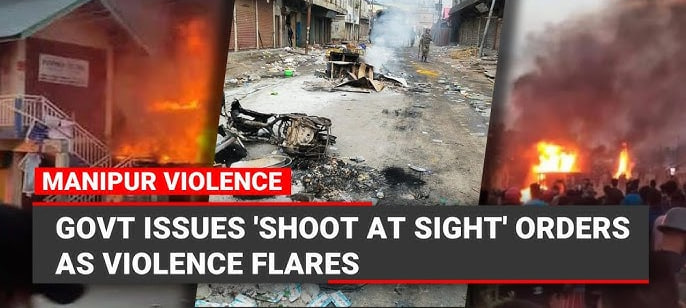Manipur case
Date: 11-05-2023
Context: Manipur, a northeastern state of India, has been witnessing violent clashes between different ethnic groups.
Details
- Manipur, a northeastern state of India, has been witnessing violent clashes between different ethnic groups since February 2023.
- The latest round of unrest erupted on May 3, when a tribal student union organized a march to protest against the demand of the non-tribal Meitei community to be included in the Scheduled Tribe (ST) list.
- The march turned violent when some protesters set fire to houses and shops belonging to Meiteis in the Churachandpur district and other parts of the state.
- The police imposed a curfew and shoot-at-sight orders to control the situation.
Background
- The conflict between the Meiteis and the tribals has a long history of political, economic and cultural grievances.
- The valley, which accounts for roughly 10% of Manipur's geography, is dominated by non-tribal Meitei, who account for more than 64% of the state's population and produce 40 of the state's 60 MLAs.
- The hills, which cover 90% of the geographical region, are home to more than 35% of the officially recognised tribes but send only 20 MLAs to the Assembly.
- While Hindus constitute the vast majority of Meiteis, followed by Muslims, the 33 recognised tribes, broadly classified as 'Any Naga tribes' and 'Any Kuki tribes,' are predominantly Christian.

-
Issue of Reservation
-
- The Meiteis, who dominate the Imphal Valley and constitute about 64% of the state's population, have been demanding ST status since 2012.
- They argue that they are an indigenous tribe who has lost their land, culture and identity due to migration and assimilation of outsiders.
- They also claim that ST status will help them preserve their ancestral land, tradition, culture and language.
- The tribals, who inhabit the surrounding hills and account for more than 35% of the population, are opposed to the Meitei demand for ST status.
- They fear that it will reduce their share of political representation, reservation benefits and land rights.
- They also accuse the Meiteis of encroaching on their ancestral lands and exploiting their natural resources.
- What triggered the conflict between the non-tribal Meitei people and other tribal groups?
- The tension between the two groups escalated in February 2023, when the state government launched an anti-drug drive that targeted poppy cultivation in the hill districts.
- The tribals alleged that the drive was a pretext to evict them from their lands and accused the government of favouring the Meiteis.
- The Manipur High Court's order on April 19 to expedite the recommendation for granting ST status to the Meiteis further inflamed the tribal sentiments and led to the massive protest on May 3.
- Conclusion
- The conflict between the Meiteis and the tribals has a long history of political, economic and cultural grievances. The Meiteis are the dominant community in the valley of Manipur, while the tribals belong to various ethnic groups living in the hills. The Meiteis have been demanding Scheduled Tribe status to protect their identity and rights from outsiders, while the tribals have been opposing this demand, fearing the loss of their privileges and autonomy. This led to violence and unrest in the state, affecting the lives and livelihoods of both communities.
- The Meiteis, who dominate the Imphal Valley and constitute about 64% of the state's population, have been demanding ST status since 2012.
